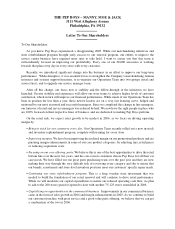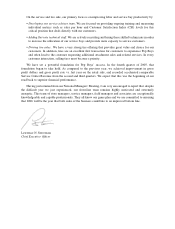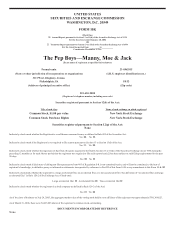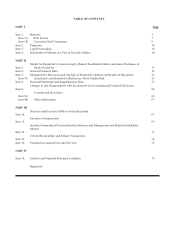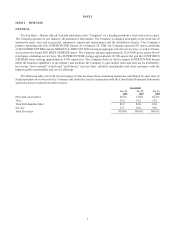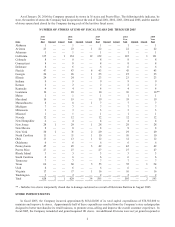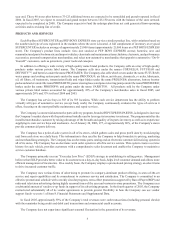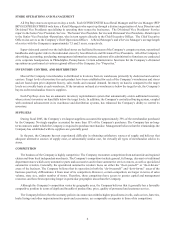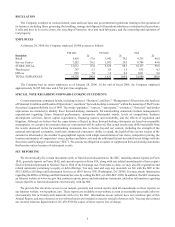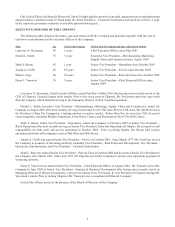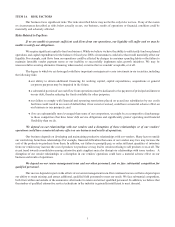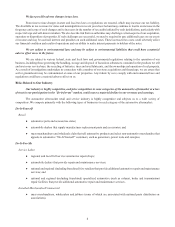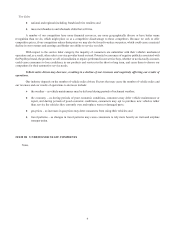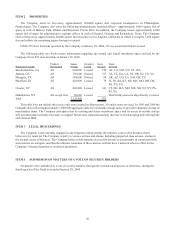Pep Boys 2005 Annual Report Download - page 8
Download and view the complete annual report
Please find page 8 of the 2005 Pep Boys annual report below. You can navigate through the pages in the report by either clicking on the pages listed below, or by using the keyword search tool below to find specific information within the annual report.3
year end. These 40 stores plus between 75-125 additional stores are expected to be remodeled and grand reopened in fiscal
2006. In fiscal 2007, we expect to remodel and grand reopen between 125-150 stores with the balance of the store network
expected to be completed in 2008. The Company expects to fund the redesign plan from net cash generated from operating
activities and its existing line of credit.
PRODUCTS AND SERVICES
Each Pep Boys SUPERCENTER and PEP BOYS EXPRESS store carries a similar product line, with variations based on
the number and type of cars registered in the markets where the store is located. A full complement of inventory at a typical
SUPERCENTER includes an average of approximately 23,000 items (approximately 21,000 items at a PEP BOYS EXPRESS
store). The Company’s product lines include: tires (not stocked at PEP BOYS EXPRESS stores); batteries; new and
remanufactured parts for domestic and import vehicles; chemicals and maintenance items; fashion, electronic, and performance
accessories; personal transportation merchandise; and select non-automotive merchandise that appeals to automotive “Do-It-
Yourself” customers, such as generators, power tools and canopies.
In addition to offering a wide variety of high quality name brand products, the Company sells an array of high quality
products under various private label names. The Company sells tires under the names CORNELL®, FUTURA® and
DEFINITYTM; and batteries under the name PROSTART®. The Company also sells wheel covers under the name FUTURA®;
water pumps and cooling system parts under the name PROCOOL®; air filters, anti-freeze, chemicals, cv axles, lubricants,
oil, oil filters, oil treatments, transmission fluids and wiper blades under the name PROLINE®; alternators, battery booster
packs and starters under the name PROSTART®; power steering hoses and power steering pumps under the name PROSTEER®;
brakes under the name PROSTOP®; and paints under the name VARSITY®. All products sold by the Company under
various private label names accounted for approximately 22% of the Company’s merchandise sales in fiscal 2005, and
approximately 26% and 33% in fiscal 2004 and 2003.
The Company has service bays in 583 of its 593 locations. While each service department has the ability to perform
virtually all types of automotive service (except body work), the Company continuously evaluates the types of services it
offers, focusing on the most profitable maintenance and repair services.
The Company’s commercial automotive parts delivery program, branded PEP EXPRESS PARTS®, is designed to increase
the Company’s market share with the professional installer and to leverage its inventory investment. The program satisfies the
installed merchandise customer by taking advantage of the breadth and quality of its parts inventory as well as its experience
supplying its own service bays and mechanics. As of January 28, 2006, 477, or approximately 80%, of the Company’s stores
provide commercial parts delivery.
The Company has a point-of-sale system in all of its stores, which gathers sales and gross profit data by stock-keeping
unit from each store on a daily basis. This information is then used by the Company to help formulate its pricing, marketing
and merchandising strategies. The Company has an electronic parts catalog and an electronic commercial invoicing system in
all of its stores. The Company has an electronic work order system in all of its service centers. This system creates a service
history for each vehicle, provides customers with a comprehensive sales document and enables the Company to maintain a
service customer database.
The Company primarily uses an “Everyday Low Price” (EDLP) strategy in establishing its selling prices. Management
believes that EDLP provides better value to its customers on a day-to-day basis, helps level customer demand and allows more
efficient management of inventories. On a weekly basis, the Company employs a promotional pricing strategy on select items
to drive increased customer traffic.
The Company uses various forms of advertising to promote its category-dominant product offering, its state-of-the-art
service and repair capabilities and its commitment to customer service and satisfaction. The Company is committed to an
effective promotional schedule with a weekly circular program, extra-effort promotions supported by Run of Paper (ROP) and
radio and television advertising during highly seasonal times of the year and various in-store promotions. The Company uses
a substantial amount of vendor co-op funds in support of its advertising program. In the fourth quarter of 2005, the Company
restructured substantially all of its vendor agreements to provide greater flexibility in how the Company can use vendor
support funds- see note 1 of Item 8. Financial Statements and Supplemental Data.
In fiscal 2005, approximately 39% of the Company’s total revenues were cash transactions (including personal checks)
with the remainder being credit and debit card transactions and commercial credit accounts.
The Company does not experience significant seasonal fluctuation in the generation of its revenues.


